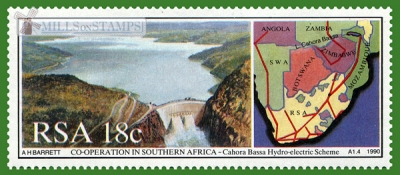-
Cooperation in Southern Africa
South Africa 1990.02.15
In issue: Stamp(s): 4 Souvenir sheet(s): 1
Printing: multicolored
-
Number by catalogue: Michel: 789 Yvert: 706 Scott: 784
Perforation type: 14 ½x14
Subject:
18 cents. Cahora Bassa hydroelectric dam*
Additional:
*All interesting information about Cahora Bassa Dam you can read here
Topics: Hydroelectricity
-
Number by catalogue: Michel: 791 Yvert: 708 Scott: 786
Perforation type: 14 ½x14
Subject:
40 cents. Lesotho Highlands Water Project*
Additional:
*The Lesotho Highlands Water Project is an ongoing water supply project with a hydropower component, developed in partnership between the governments of Lesotho and South Africa. It comprises a system of several large dams and tunnels throughout Lesotho and South Africa. In Lesotho, it involves the rivers Malibamatso, Matsoku, Senqunyane and Senqu. In South Africa, it involves the Vaal River. It is Africa's largest water transfer scheme.
The purpose of the project is to provide Lesotho with a source of income in exchange for the provision of water to the central Gauteng province where the majority of industrial and mining activity occurs in South Africa, as well as to generate hydroelectric power for Lesotho (currently almost 100% of Lesotho's requirements).
Efforts to create a dam in the location were spearheaded by then British High Commissioner Sir Evelyn Baring in the 1950s. After a complete feasibility study was conducted between August 1983 and August 1986 (German-British Lahmeyer MacDonald Consortium was appointed for this task), the project eventually began to realize.
The project has also been alleged to have had negative social and environmental effects. While compensation was provided in kind and paid to the few hundred households affected by the dams, there is criticism that it was insufficient. It was not intended to address the water supply problems in Lesotho, but by paying royalties to the Lesotho Government for development purposes benefits have reached much of the population.
In recent years, water from the scheme has been discharged into the Mohokare (Caledon) river to provide water to Maseru in times of critical shortages. The new dams have filled as anticipated and discharge of water from the dams into the downstream rivers continues in a scheme devised to preserve ecological balances. This discharged water flows to the Senqu (Orange) and while preserving the ecological status quo benefits only those communities along the rivers.
The project has had an important impact on Lesotho's infrastructure, as hundreds of kilometers of engineered paved roads were built in order to improve access to the different construction sites, and, together with engineered unpaved 'feeder' roads around the dams, continue to provide much improved communication for many villages in the mountainous interior.
Since its inception the project has been dogged by corruption which has resulted in a number of court cases involving both individuals and multinational corporations.__________
This information has been taken from Wikipedia
Topics: Hydroelectricity
-
Number by catalogue: Michel: Block 24 Yvert: BF24 Scott: 787a
Perforation: Harrow Perforation type: 14 ½x14
Size (of sheet, booklet) mm: 137x78
Topics: Hydroelectricity



1990-2s-logo.jpg)
1990-ss-logo.jpg)